Artists at Work: Julia Haft-Candell
by Anna Katz
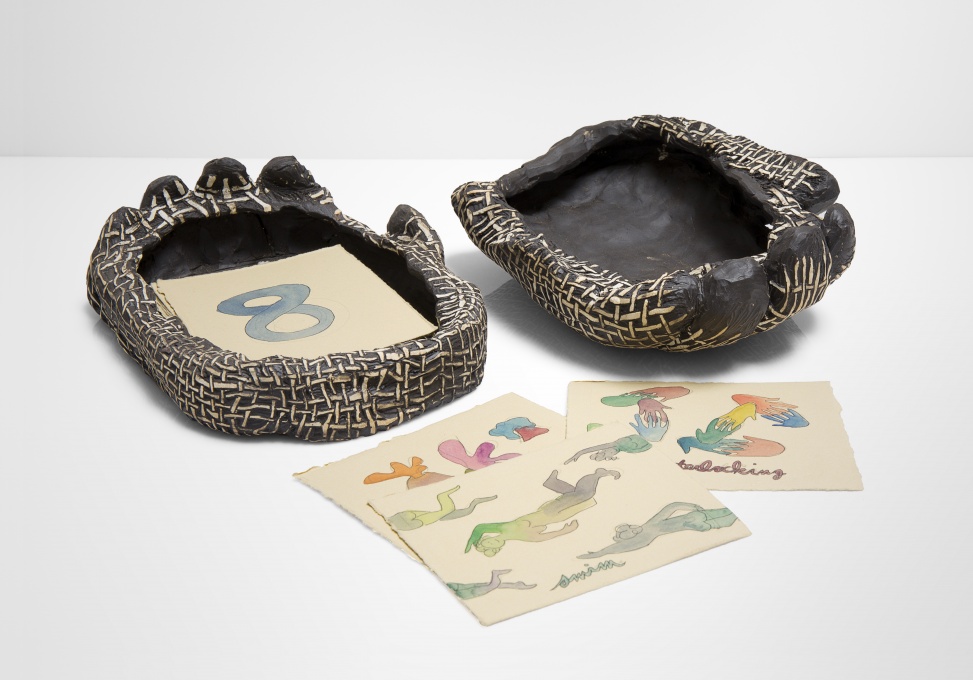
Julia Haft-Candell, the infinite Deck, 2021. Ceramic, watercolor, ink, paper; 2.75 x 8 x 5.5 in. ceramic box with 4 x 5 in. paper drawings. Photo: Makenzie Goodman. All images courtesy of the artist.
For nearly a decade, Julia Haft-Candell’s ceramic sculptures have been drawn from a consistent vocabulary of forms: knots, combs, interlocking hands, braids, and infinity symbols, among others. In 2017, she created a glossary, which she refers to as “the infinite,” that articulates definitions and contexts for these forms, ranging from personal association to social significance, especially as pertains to gender and the history of craft, and philosophical, even utopian, potential. Haft-Candell, who also draws, paints, and casts in bronze, began working in ceramics as an undergraduate at the University of California, Davis (BA 2005), and continued her work with the clay medium in her graduate studies at California State University, Long Beach (MFA 2010). In November 2021, Anna Katz sat down with Haft-Candell in her Glassell Park studio to discuss the ways in which she approaches ceramics as a container for ideas; the sometimes vexing trend towards “lumpiness” in ceramics today; and the place of art history in the infinite school, an alternative to institutional ceramics instruction that she founded in 2014.
Anna Katz: I want to start by asking you about the glossary you developed in 2017, the infinite. It’s a glossary of terms, but it’s also a lexicon for your forms in ceramics, drawing, and painting. Can you tell us about the infinite, how the idea came about and a bit of a description?
Julia Haft-Candell: I was looking for a way to write about my work that was expansive rather than constraining, which is how artist statements usually feel. I was exploring different ways to write about my work more creatively, while also reading a lot of science fiction, mostly by Ursula K. Le Guin and Octavia Butler, both of whom use science fiction to discuss social issues and issues that felt very contemporary. For example, in [Octavia Butler’s] Parable of the Sower, one of her main protagonists has invented a religion, Earthseed, that is all about community and honoring the earth and using bits of language and practice from things like Judeo-Christian beliefs, but made into this very community-based, emergent feminist, harmonious religion. So there’s a fictional book about a fictional religion, and I really liked that as a model.
Or, in The Left Hand of Darkness by Ursula K. Le Guin, which I was reading at about that same time, there’s a planet called Gethen whose inhabitants are androgynous. They don’t express gender, and they only start expressing gender once they’re ready to mate—they consider humans to be perverts because they’re always expressing a gender. So I realized fiction could rewrite these definitions of things we take for granted, and that was really powerful. I started thinking about all of the things I had been making in my sculpture and drawing over the last few years. There were certain things that had been repeating: chains, hands, infinities, eyes, knots, in imagery or in shape. I analyzed them, I gave myself a critique—like, what do they reference, what do they make you feel? And I wrote definitions based on personal memory and what they brought up for me in terms of social significance. There was a lot of tie-in to gender and craft, and creating metaphors from those definitions, so the glossary came from the work and not vice versa.
AK: Can you give an example of how a definition in the glossary works?
JHC: Yeah, the definition of the infinity talks about how the infinity symbol itself is a paradox (“paradox” is something that comes up a lot in the glossary). It is a paradox in how it is a symbol we use to define the indefinable. That, to me, is exciting because it’s absurd. It’s funny. I was thinking about the different shapes related to human anatomy and how the infinity symbol felt both very masculine and feminine, depending, and how it was like this phallic thrusting form that created these openings. Depending on how it was drawn or sculpted, it could be more phallic or vaginal or both. Because I was thinking a lot about gender and this Ursula Le Guin book, I was thinking about how infinity was hermaphroditic and could take on gender based on survival—some organisms do that, like worms and sea creatures. Also the reference to religion, the reference to math—I bring all of that in the definition.
AK: And sometimes, it’s not about gender and evolution. The comb is an example: it’s defined in the glossary as a thing used to separate things, a decorative object associated with women’s accoutrements.
JHC: But then with the comb too, I talk about how it reminds me of my dad because he always had a comb in his pocket, cute things like that. What’s important in most of the glossary is to have this combination of the personal, social, sometimes political—making up a rewritten definition for something we think of as everyday and insignificant.
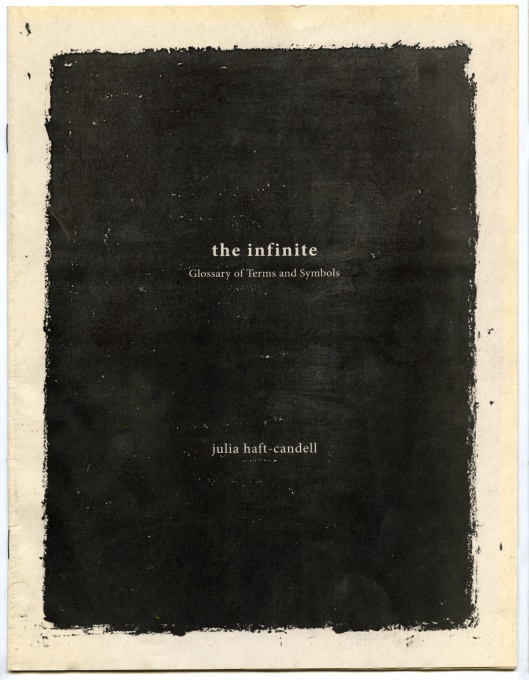
Julia Haft-Candell, the infinite: Glossary of Terms and Symbols, 2017. Newsprint and ink zine, 8 x 10.5 in. Edition of 500.
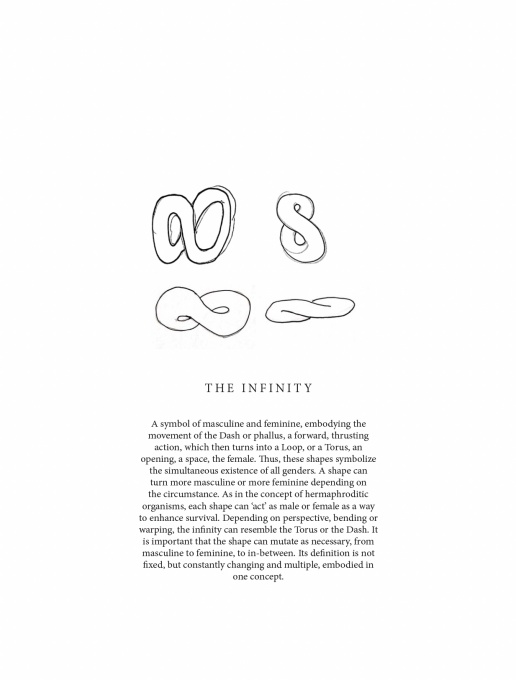
Julia Haft-Candell, The Infinity, excerpt from the infinite: Glossary of Terms and Symbols, 2017.
AK: So the infinite wasn’t a road map for your sculpture, it was a user’s manual you wrote afterwards. But you still, obediently or even sometimes purposefully disobediently, use those forms as the building blocks of your forms in sculpture?
JHC: I use it as a way to ground myself. Clay can do so many different things, and I feel unlimited in terms of what I can make. I use the material to explore in so many ways that by having this framework, it helps me feel more grounded. Sometimes I think of it as just for me, and that’s fine. But also when I made the original glossary, it was a zine that I had at an exhibition called the infinite [at Parrasch Heijnen Gallery, Los Angeles, in 2017], where there were infinity sculptures with different motifs carved on them. Each motif was an entry in the glossary, and the glossary was available for free to viewers to get more background.
AK: If we look at your sculpture Swim (2020)—you showed it outdoors last year at Night Gallery—it’s a glazed ceramic sculpture. It’s vertical. It’s four feet tall. It’s a piece with a front and a back, like a person. What I want to ask you about here is this idea of sculpture as fiction, or fiction as a model.
The fiction of Swim is that two different kinds of matter are coming together. One would be this stone-like, four-fingered hand with separated digits. Then there are these three globs of matter that look like unfired clay. They look unformed, like they’ve been squeezed and pushed. And the illusion is that those globs are being squeezed by the fingers or jammed into the fingers, and the dripping glaze buoys this impression. But that’s not how it was made. It’s coil construction and was made bottom-up and is one piece. I’d like to hear you talk about paradox in this work and how to use the infinite glossary to make meaning from it.
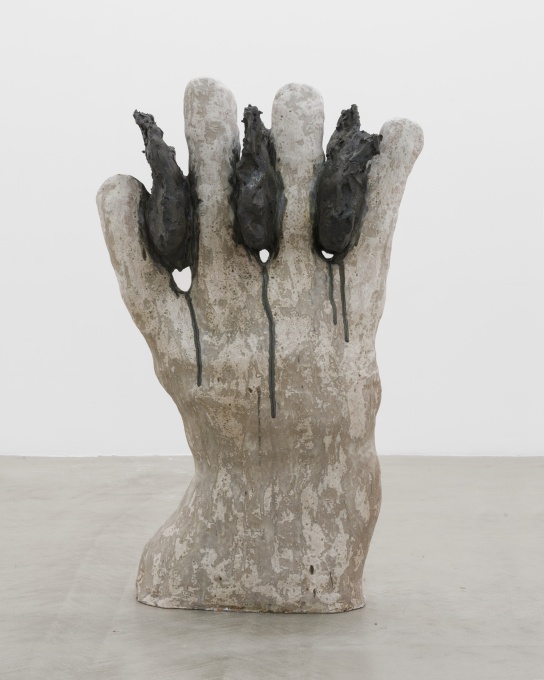
Julia Haft-Candell, Swim, 2020. Ceramic, 51 x 32.5 x 15 in. Photo: Ed Mumford.
JHC: The piece was inspired by an idea to try to sculpt the water that gets stuck between our fingers while swimming, like hands scooping through water. How would one sculpt that out of this heavy, solid material?
There’s a puzzle in making this which I really enjoy, and in how I want it to feel like things found and stuck and grabbed between fingers. But, in terms of the process of working with this material, I needed to figure out a way where it would be sturdy and cohesive and not fall apart and explode. The process is the same process of making a small coil pot: working from the bottom up and making the contour at the same time, so each of these parts in between are actually hollow and connected to the anchors. There’s something really poetic about process as metaphor, and vice versa, in having these two seemingly opposing things made from the same material. They really do need each other.
The Nothing/Everything is the bits in between. That’s also an entry in the glossary. It relates to everything: the primordial goo, the sea, the dirt, the center of the earth, maybe the cosmos, the guts. I call the hand a hand/feeler because I sculpt them generally with four fingers as a way to take them outside of specific recognizability of a human hand, while they still reference hands.
I’m really interested in contradiction, in paradox. I talk a lot about binary in the glossary, and having to go back and forth between various binaries to find some space in the middle. So thinking about the foreground/background as a binary and smooshing that—the paradox of combining the negative space with the positive space in one form, and then the hand as these two different binaries and just complicating that. There is also this idea of having multiple realities, like existing as both this and this.
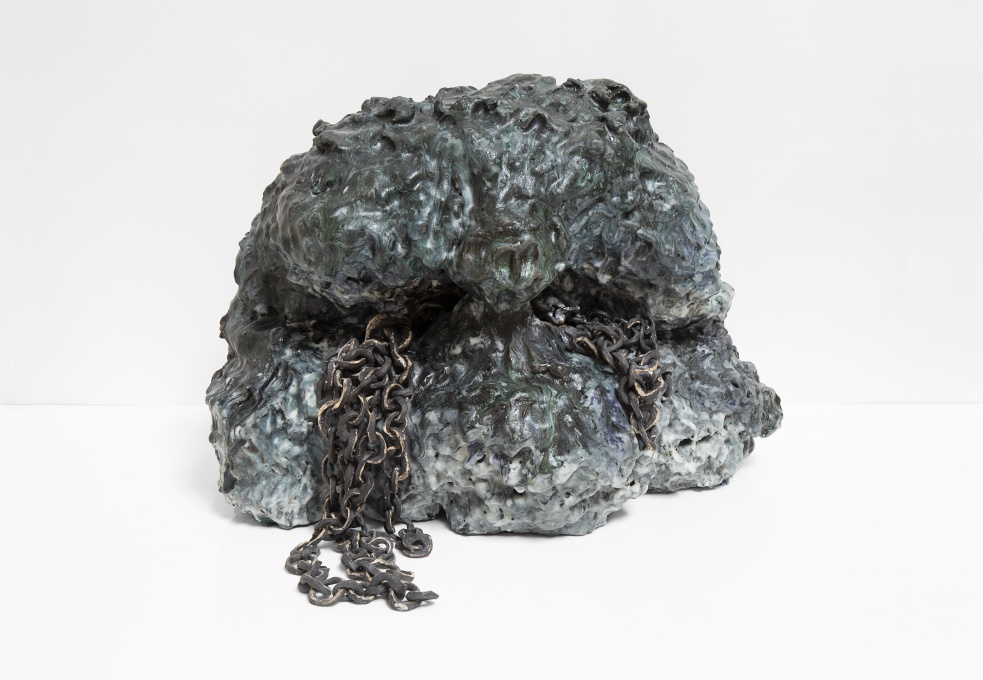
Julia Haft-Candell, Nothing/Everything Devouring Chains, 2020. Ceramic, 14 x 21.5 x 12 in. Photo: Makenzie Goodman.
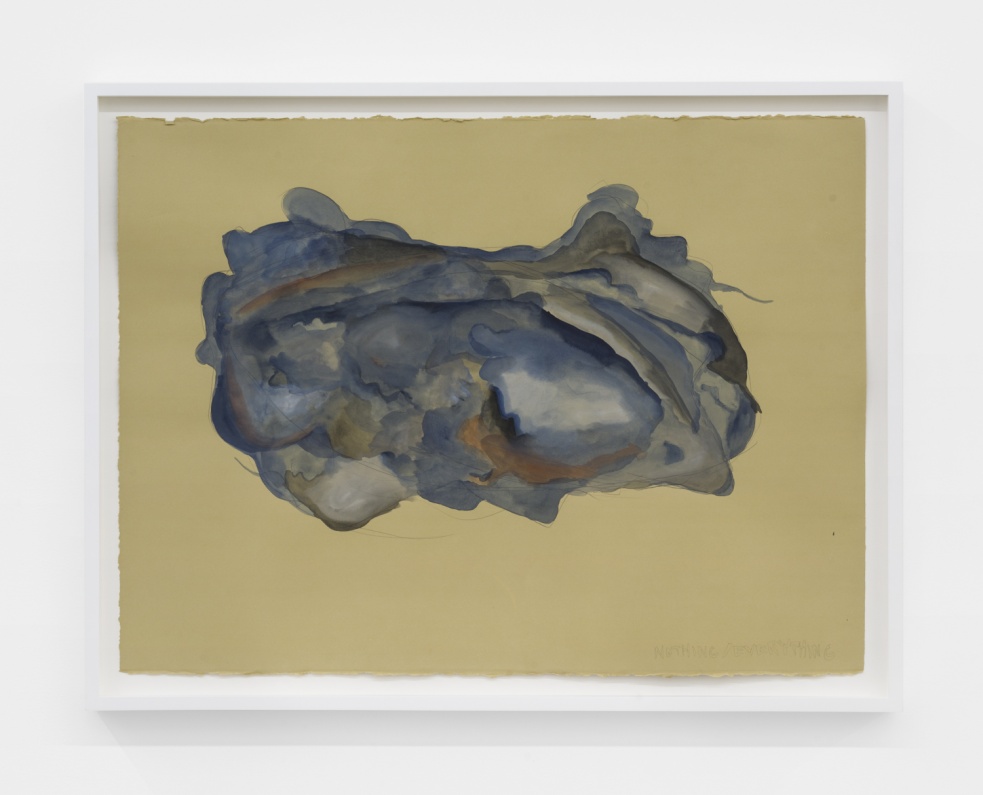
Julia Haft-Candell, Nothing/Everything, 2020. Watercolor, ink and pencil on paper, 22 x 30 in. Photo: Ed Mumford.
AK: The both/and. That’s what all this allows you, and that’s the metaphor of science fiction, right? That it doesn’t have to be either/or, it’s the both/and, hence the emphasis on action and stasis, on scale and ephemerality.
JHC: Yeah. Then there’s the challenge of trying to make a sculpture out of all of that, out of this material that is very fluid in a wet state and then fires very hard and permanent, and all of the complications that brings. Swim being fairly large scale, it starts to reference more of a monumental form, of more traditional monuments, and questions, how do you make a monument that’s messy and complicated and a little bit gross? Sometimes I think about this as a self-referential piece, too, of my hand making it because that’s what happens when I work in clay, clawing through it and ending up with these chunks between my fingers, so it ends up being an homage to the making of itself.
AK: I want to ask you about your relationship to disciplinarity, specifically in relation to what I see in a lot of ceramics. Your work shares a lot of qualities associated with the prominence of deskilled ceramics—the bubbling glazes, the dense textures, a lack of fussiness, and a provisional lumpiness. You came to your material by way of drawing and painting, and you developed yourself in ceramics through experimentation; your knowledge comes through experience rather than a formal ceramics training—you never studied wheel throwing, or at least not properly. You were never a potter, and therefore, like a lot of artists working with clay, you don’t belong in the ceramics world in a narrow sense. So, how do you conceive of a lineage or a tradition? How do you develop your practice in terms of standards? How do you conceive of rigor or criticism, the basis of judgment?
JHC: It’s complicated because of the bothness, being in both worlds, one being ceramics and one being art. There’s a Venn diagram and I know that the art world can encompass the ceramics world and the ceramics world can encompass art, but usually they are separate worlds. I came from a place of making work inspired by modernist painters, like Matisse, or sculptors that traverse mediums, like Louise Bourgeois. My inspiration, when I started working with clay (and still now), is not usually ceramic artists. But there are some ceramic artists that I really love, too. I got my MFA in 2010. When I graduated I think the trend and the moment of ceramics that we’re in now was just starting again; ceramics was popular. That was fairly recent, so I was showing work in galleries that were not medium-specific, and I didn’t really feel much of the ceramics baggage that my professors and their professors maybe felt. You know, there are anecdotes I’ve heard about Betty Woodman and her work not being looked at at Frieze in New York; they wouldn’t show it in the 80s! So that’s a real fact that’s hard to imagine now, because now there’s ceramics everywhere. But I was aware of this recent shift and of the fickle nature of the art world that’s like, “we love you,” “we hate you.” And the truth is in the 60s there was a ceramics craze and it comes and goes and comes and goes. I love working in clay, but also there’s this baggage that comes with it that sometimes I get tired of.
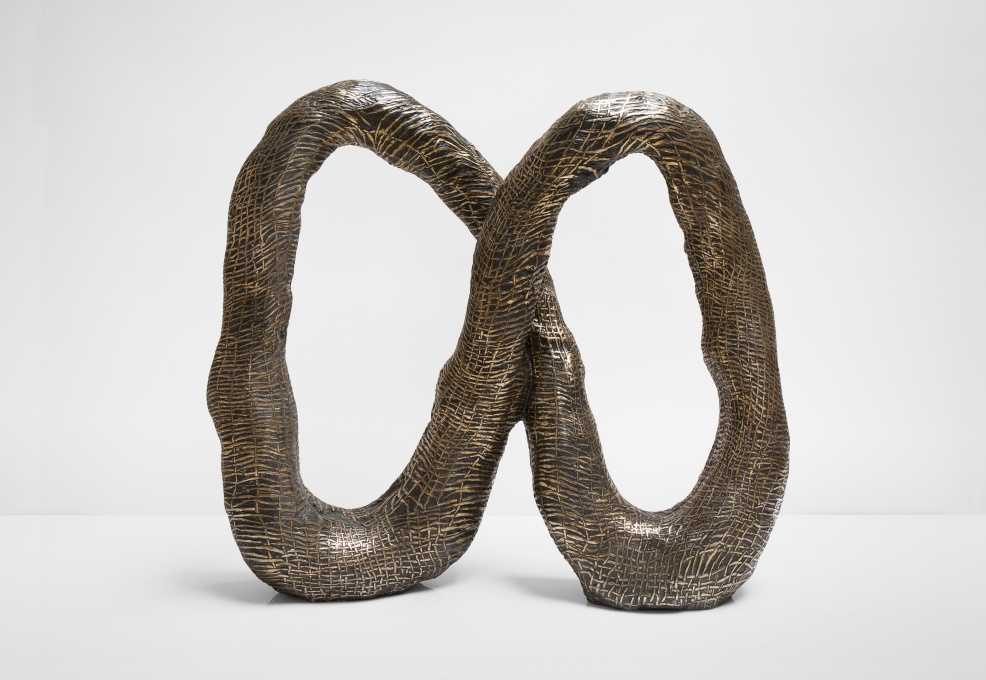
Julia Haft-Candell, Woven Infinity, 2021. Bronze, 20.5 x 22.75 x 7 in. Photo: Makenzie Goodman.
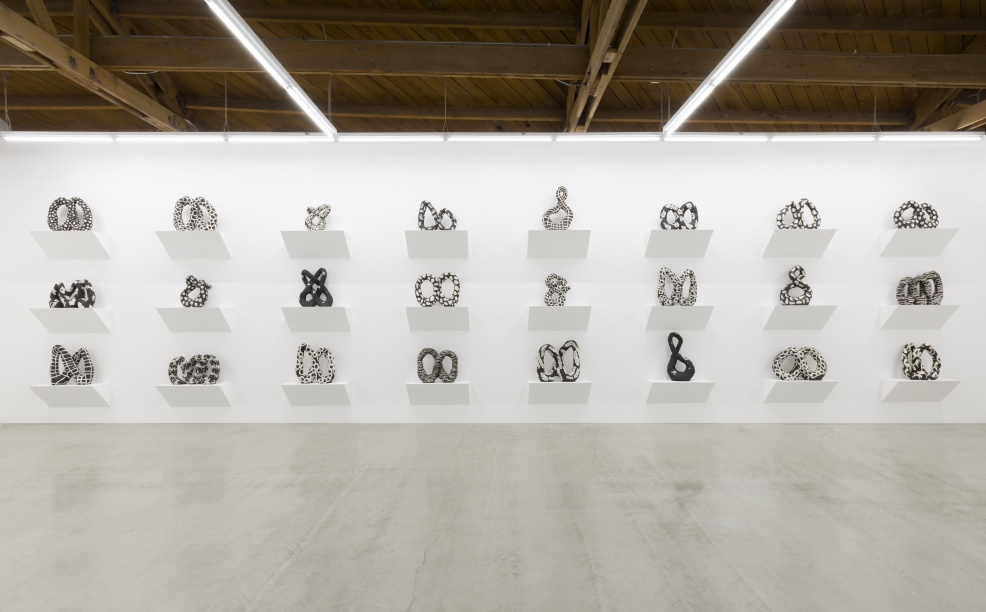
Julia Haft-Candell, the infinite, exhibition view, Parrasch Heijnen Gallery, Los Angeles, 2017. Photo: Jeff McLane.
AK: Is the baggage that people like me are constantly asking you about working in clay?
JHC: Yeah! The thing is, I feel that sometimes I say, “OK, clay is just a means to an end. It’s a material.” But then sometimes I’m like, “no, it’s guiding me. Its ‘clay-ness’ is guiding what I make and how I make it.” So, it is both unimportant and very important at the same time. What I realized recently from experimenting with other materials is that it’s more about material guiding my work, rather than this specific material (clay). It’s just that clay does it really well because of its mutability and versatility. It’s a very paradoxical relationship with ceramics and clay and because of that I think, both within the ceramics world and without, there are different ideas and standards and lineages that have inundated me subconsciously that I’m reacting against. Within the ceramics world, there are standards in place for traditional pottery that are still taught in sculpture classes—like, “only make something an inch thick and fire cone 10,” traditional bisque fire, glaze fire—that I’m actively working against in trying to add a fired piece to an unfired piece, or firing something solid. Within the art world, there are these other standards. Especially when I was in school, the mindset within sculpture was very different from ceramics. I was in a program that had a ceramics department and a 3D department. It’s very different having critiques with the sculpture department versus the ceramics department.
AK: Were they only asking about concept?
JHC: Yeah, and talking a lot about how you can’t just have something be formal, whatever that meant. My professors were coming from a time when everything was very concept-based and there must be a meaning guiding the work that’s external to the work. It was rarer for things to be material-based. That was what was reactive in that realm: being very invested in the material, in a craft material, and letting intuition guide these things, things about feelings. So in that way, I am reacting against the generalized art world. I’m reacting against these two separate conversations, and that ends up being this third thing that is my work.
AK: If we could stick with lumpiness… I appreciate that you don’t bristle at the ascription of this term and that you know what I’m talking about when I talk about the lumpy trend. Can you say how you think about your work’s relationship to the preponderance of lumpiness and help me figure out what to make of all the lumps?
JHC: OK, yes, here I am comfortable. I think that it’s important to note that lumpiness has been around for a while. Clay allows itself to be lumpy pretty readily, like a pinch pot. Pinch a handful of clay and it’s an amazing lumpy sculpture all of a sudden. My old professor Annabeth Rosen used to say—we would make a big pile of clay—and she’d say, “that’s the most beautiful sculpture you’ll ever make!” And she’s right because it does something visceral for us as humans. It’s intensely existential—it shows your existence, it’s permanent. It connects you with this history of earliest humankind doing the same thing. It references dirt and shit and all the things that we are embarrassed by but love, and that confusion in between. And it’s hard. It’s also just harder to make clay not lumpy. It takes time, tools, skill, patience. A lot of the joy of using clay is the immediacy of it all and that is removed when you have to smooth something out. And then glaze! Glaze is melting chemicals in a hot, hot kiln. Those are the same chemicals that are in the earth and the cosmos; the metaphor of it all is so apt for goopiness and lumpiness.
John Mason was making lumps in the 60s, and Voulkos… It’s not anything new. The trend is something about how photogenic it is to photograph something lumpy and goopy and how that presents a prime opportunity, like Glenn Adamson talks about the “hyperpot.” My work has lumpiness in it for the reasons that I mentioned, maybe not the photogeneity, but the what-clay-wants-aspect, the existential, the earth and cosmos and chaos of it all, the connection to early humans. I’m using clay because of its versatility, so there’s also a lot of non-lumpy. A lot of the trendy goopy lumpiness right now, I think, is solely about that and not about a lot more. I think of it as extreme with an X, like the X Games—X-treme Glazing, X-treme Firing, “I’ve fired this twenty times!” My work relates to all these ideas I talk about in the infinite that sometimes includes lumpiness, but often doesn’t. Often it’s about smoothing or carving or employing different techniques. A lot of the pieces do have this opposing lumpiness versus not-lumpiness in one form, like Swim. The meaning wouldn’t be possible with just one or the other.
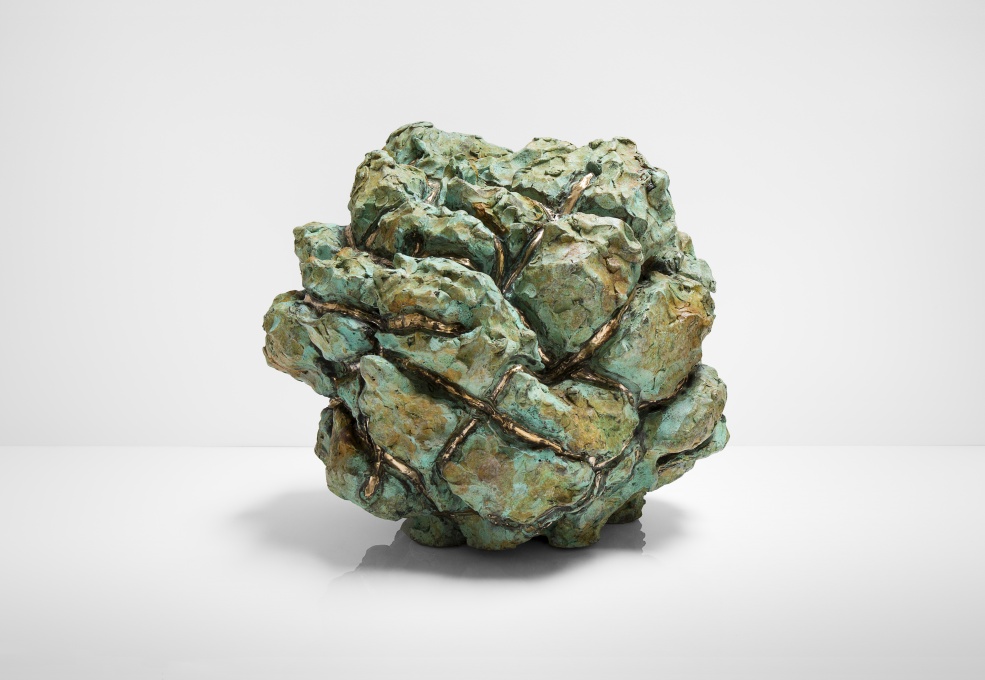
Julia Haft-Candell, Expanding Green and Ochre, 2021. Bronze, 11.75 x 12.5 x 13.5 in. Photo: Makenzie Goodman.
AK: the infinite is something that you made as a user’s manual for your forms, and it’s also the case that the idea of building new contexts, of redefining terms, of even making alternate environments has a practical and pedagogical application with the infinite school, a non-institutional experimental space for ceramic education run out of your studio in Glassell Park. What is the infinite school? What’s the curriculum?
JHC: the infinite school is a school that offers quality art education outside the traditional academic institution. At this point, it is ceramics-based, but I am open to the idea of it evolving into a wider art school. So far, I’ve taught classes on building large-scale ceramic sculptures in parts and glaze mixing. In 2022, I’m expanding to have other people teach classes, so it won’t just be me. That’s basically my curriculum.
My students tend to be artists who have worked or are interested in working with clay, but who have not been formally trained in the material and want more focused learning to learn specific skills. I started doing it because I was frustrated with academia and its gatekeepers and waiting for them to offer me a class or having them cancel class—typical adjunct instructor woes. I was fed up with that as a system and realized that I had the facilities, I had the community, and I could just take it into my own hands; I saw this niche. There are these traditional academic institutions where you have to be a student or have a relationship with a professor there in order to use the facilities, or you have a private ceramics studio where you can be a member and take a class, but it’s pretty limited in terms of the classes they offer and it’s very hands-off in terms of firings. You can’t really experiment, you don’t get one-on-one time. So there’s this in-between that I thought people would appreciate, this very intimately-sized class where we are learning these supposedly advanced skills, which I argue are not advanced, but skills that they weren’t learning in other places. These are things that often won’t be taught; someone will go through their whole ceramics education in college and never learn how to build large-scale or never learn glaze mixing unless they take a specific class. I thought that was silly. A big part of the goal for the infinite school was to demystify the ceramic medium so that people feel less afraid to experiment, so that people feel less reliant on the gatekeepers. I wanted to empower individuals to be more self-sufficient in working with clay.
I don’t think these skills are advanced. I think that they’re inconvenient to teach because when you work large it takes a lot of space and it’s hard to load kilns. It’s really physical, and when you mix glazes you get stuff that runs and messes up shelves. It’s just inconvenient, but it’s not hard. It’s really not. In knowing those two very simple things, it opens up so much to not rely on store-bought glazes, which are very limited and expensive, and to be able to make really big sculptures without needing a giant kiln.
AK: How do you run a school out of a studio and keep the vibe?
JHC: I offer small classes, four to six people. So far they’re in the evenings, so that if people have jobs they can come afterwards, either one or two days a week, depending on when I’m offering it. A lot of the students are also educators themselves, so they are passing on the knowledge, which is exciting. Some of them are students who don’t have the facilities and resources to learn. Sometimes they are designers making pots and selling them and want to make bigger pots or a lamp or something. It’s pretty open. Part of it is to create community, so I am very specific about creating these classes in terms of wanting to provide a space for people who might not feel comfortable in these often very macho ceramics environments.
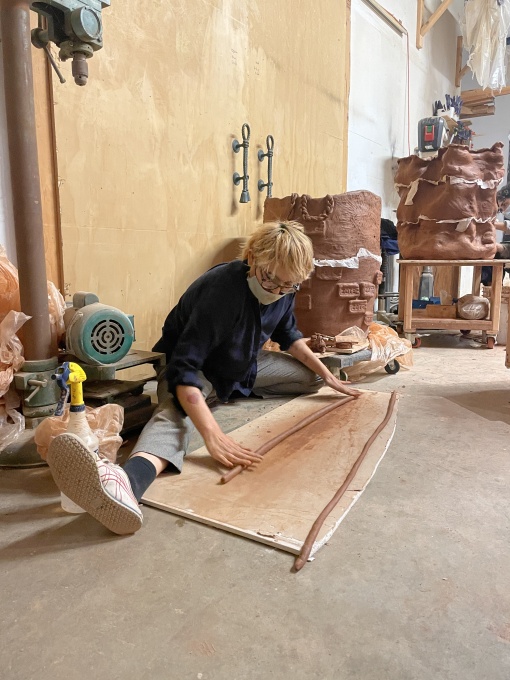
Pam Aliaga in a Build Big class at the infinite school, 2021. Photo: Julia Haft-Candell.
AK: That’s the demystification part. What are the historical precedents for this instruction? You’ve cited Marguerite Wildenhain’s Pond Farm Art School Colony as a reference. Do you look to these as models in a potentially utopian or political or otherwise ambitious sense?
JHC: The Pond School is exciting because Wildenhain took matters into her own hands and offered pottery classes in a barn in Northern California, and it’s the same utopic attitude as Black Mountain College or Skowhegan, these places that are now institutions but started as alternative schools. I’ve also been really inspired by Pot L.A., which is a pottery studio in Los Angeles. Its purpose is to create space for people of color in the mostly white private pottery studio world. They’ve created a space that is a school (even though it’s not) because it offers classes. They build community that’s outside of, again, this ceramics world that I often reference as problematic. So that serves as inspiration for me, too.
AK: Talking about the infinite school and the lack of diversity—whiteness—in ceramic history, not just ceramic instruction, I want to ask you about one of the core values of the infinite school, which is building new ceramic histories. This refers to your work and your students’ work, conceiving of what you’re doing in the present moment as building a new history for the future. But it must also refer to the art historical narratives that you rely on and relay. How, if at all, do you relay the narrative of ceramics in L.A., a narrative which has been, reductively, codified as the story of Peter Voulkos at Otis having a lasting influence on John Mason and Ken Price? It’s a recasting of the craft medium in the mold of modern sculpture, with parallels to Abstract Expressionism, Minimalism, and Pop. It’s a narrative that’s steeped in masculinist myth and the sexism has also been codified.
It’s not new for me to say that the narrative includes the notion that these great heroic men could transcend the pejorative associations of clay, associations with femininity, craft, or non-Western others; that these are colonialist myths; that a medium that was developed with great complexity quite literally around the world for millennia could be discovered, as if anew, in the hands of white American men. It would only make sense that you, in the infinite school and in your teaching, decenter this narrative; that you would treat it as one strand, among others; that you would contextualize it critically. But in your efforts to diversify the history of art you share with your students, how do you avoid imitating that very same pattern of discovery, of severing the objects you present from their historical and cultural contexts? How do you teach ceramics history, particularly when questions of authority and ownership of tradition and cultural appropriation are at the forefront of many artists’ practices?
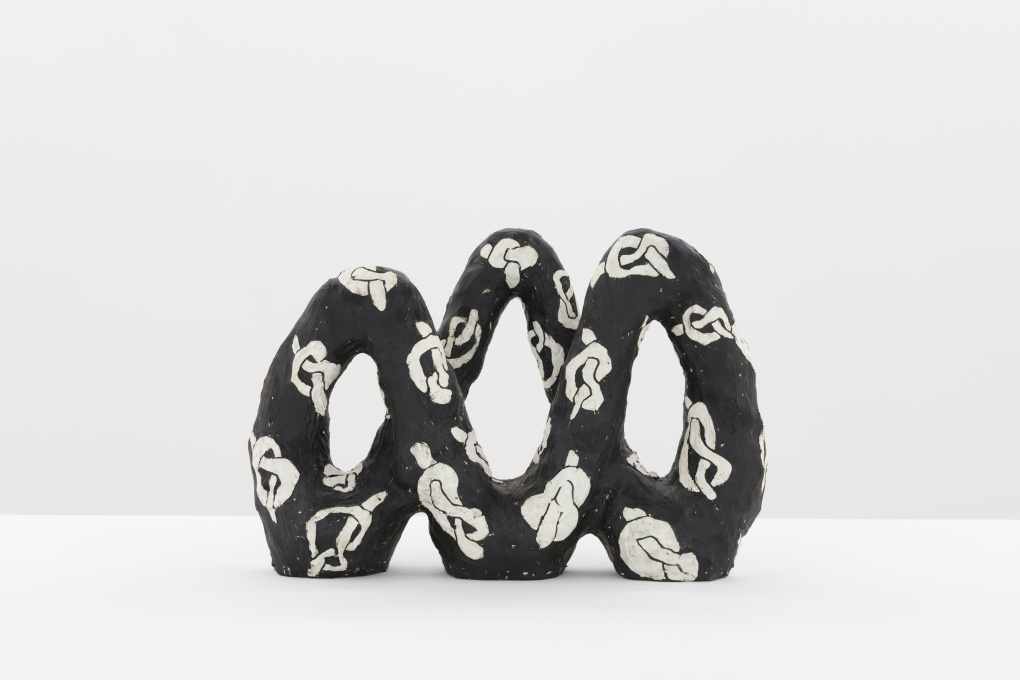
Julia Haft-Candell, Infinity: Knots, 2017. Black clay and underglaze, 17 x 22 x 5 in. Photo: Jeff McLane.
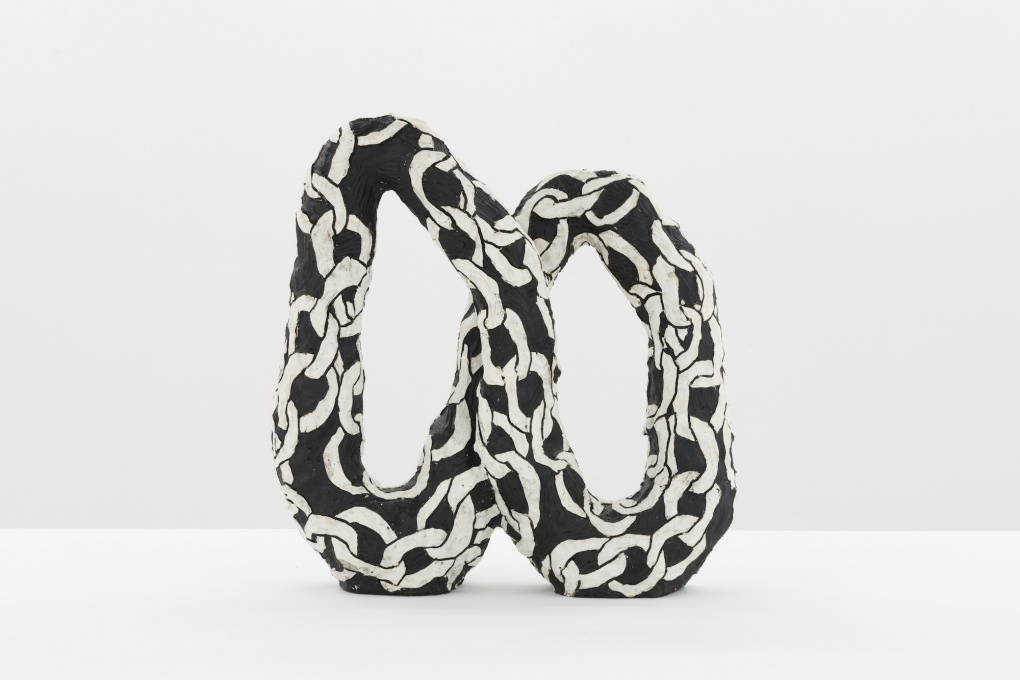
Julia Haft-Candell, Infinity: Chain, 2017. Black clay and underglaze, 19 x 19 x 5 in. Photo: Jeff McLane.
JHC: I do and I don’t teach history. Most of the way that I teach history in the infinite school is through conversation. I love that I’m not lecturing and I’m not showing slides. I’m not formally doing any of that, but it does come up because I’m interested in questioning history, and because I have a reputation of challenging the patriarchy within ceramics. It comes up often in class, but in conversation. That is how we do it. It’s not top-down, it’s not me telling them a history. It’s a discussion about things that have happened. It’s different stories. When it’s telling histories, that is complicated because you’re often discrediting one thing with another, and then that gets discredited, and it’s an endless back and forth. But that’s the process. I think that feels tedious, but it also feels less and less tedious the more you do it. I got excited when one of my students didn’t know who Peter Voulkos was because of how different that is from the top-down approach of teaching ceramic art history. I don’t feel there’s anything wrong with that student not knowing Peter Voulkos. They’ll find out. I don’t feel like anything is really getting lost by not having a formal history lesson.
I was going to call this core value “retelling ceramic histories,” but even in that, in order to retell it you have to bring up this old thing and challenge it, and who knows what that story is? I was just so tired of talking about those three men, that “building ceramic history” felt much more like recognizing that this is going to be history later, that histories are made from just people doing things and you can be in charge of creating your own history. It felt empowering to recognize that, rather than tedious. This goes back to the idea of the infinite and the glossary, too. It felt restrictive to think about it as this formal statement, but if I thought about it as a glossary, as something that was evolving, then it felt empowering and generative. That’s how I feel about the infinite school, too.
AK: And the cost is that your students might make work that’s already been done before, and that the criticism would be, “Have you not seen the work of some artist who I might think everyone does know or should know?!” That’s the risk.
JHC: I would argue that happens anyway. That might happen more if they know the artist, because they’re seen as something to aspire to. I’ll have students in other realms, in academic institutions, who will show me a picture of something on Instagram that they want to make, so it’s going to happen anyway. Students will do that, artists are doing that, rehashing what was done in the 60s and not just ceramics. I don’t think it’s a big cost.